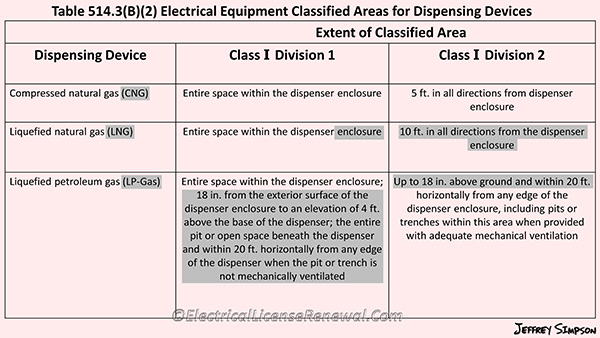514.3(B)(2) Compressed Natural Gas, Liquefied Natural Gas, and Liquefied Petroleum Gas Areas.

Code Change Summary: Revisions were made to the requirements for classifying the areas where compressed natural gas (CNG), liquefied natural gas (LNG), and liquefied petroleum gas (LP) are dispensed.
In the 2017 NEC®, Section 514.3(B)(2) and the associated table were revised to align with code language pertaining to CNG, LNG and LP gas, found in NFPA 30A-2015 Code for Motor Fuel Dispensing Facilities and Repair Garages.
The new text in 514.3(B)(2) states that Table 514.3(B)(2) must be used “to delineate and classify areas where CNG, LNG, compressed or liquefied hydrogen, LP-Gas, or combinations of these, are dispensed as motor vehicle fuels along with Class I or Class II liquids that are also dispensed as motor vehicle fuels”. The revised table does not have a specific column for liquefied hydrogen gas but it does have a column for liquefied natural gas.
Another gray area is that the table must be used “to delineate and classify areas where CNG, LNG, compressed or liquefied hydrogen, LP-Gas, or combinations of these, are dispensed as motor vehicle fuels along with Class I or Class II liquids that are also dispensed as motor vehicle fuels”. So, the question is: What if the facility is just a CNG facility only and other Class I or Class II liquids are not also dispensed? Is the table still required to be used? It is likely that this section will see revisions in the next code cycle.
Another change occurred to the minimum required distance between an LP gas dispenser and other dispensers for Class I liquids. The general rule is that there must be at least 10 feet between the dispensers with an allowable reduction to 5 feet if the following conditions exist:
- The LP-Gas deliver nozzle and filler valve release no more than 0.1 oz of liquid upon disconnection.
- The fixed maximum liquid level gauge remains closed during the entire refueling process.
Below is a preview of the NEC®. See the actual NEC® text at NFPA.ORG for the complete code section. Once there, click on their link to free access to the 2017 NEC® edition of NFPA 70.
2014 Code Language:
514.3(B)(2) Compressed Natural Gas, Liquefied Natural Gas, and Liquefied Petroleum Gas Areas. Table 514.3(B)(2) shall be used to delineate and classify areas where compressed natural gas (CNG), liquefied natural gas (LNG), or liquefied petroleum gas (LPG) is stored, handled, or dispensed. Where CNG or LNG dispensers are installed beneath a canopy or enclosure, either the canopy or the enclosure shall be designed to prevent accumulation or entrapment of ignitable vapors, or all electrical equipment installed beneath the canopy or enclosure shall be suitable for Class I, Division 2 hazardous (classified) locations. Dispensing devices for liquefied petroleum gas shall be located not less than 1.5 m (5 ft) from any dispensing device for Class I liquids.
2017 Code Language:
514.3(B)(2) Compressed Natural Gas, Liquefied Natural Gas, and Liquefied Petroleum Gas Areas. Table 514.3(B)(2) shall be used to delineate and classify areas where CNG, LNG, compressed or liquefied hydrogen, LP-Gas, or combinations of these, are dispensed as motor vehicle fuels along with Class I or Class II liquids that are also dispensed as motor vehicle fuels.
Where CNG or LNG dispensers are installed beneath a canopy or enclosure, either the canopy or enclosure shall be designed to prevent accumulation or entrapment of ignitable vapors or all electrical equipment installed beneath the canopy or enclosure shall be suitable for Class I, Division 2 hazardous (classified) locations. [30A:12.4]
Dispensing devices for LP-Gas shall be located as follows:
(1) At least 3 m (10 ft) from any dispensing device for Class I liquids
(2) At least 1.5 m (5 ft) from any dispensing device for Class I liquids where the following conditions exist:
a. The LP-Gas deliver nozzle and filler valve release no more than 4 cm3 (0.1 oz) of liquid upon disconnection.
b. The fixed maximum liquid level gauge remains closed during the entire refueling process.